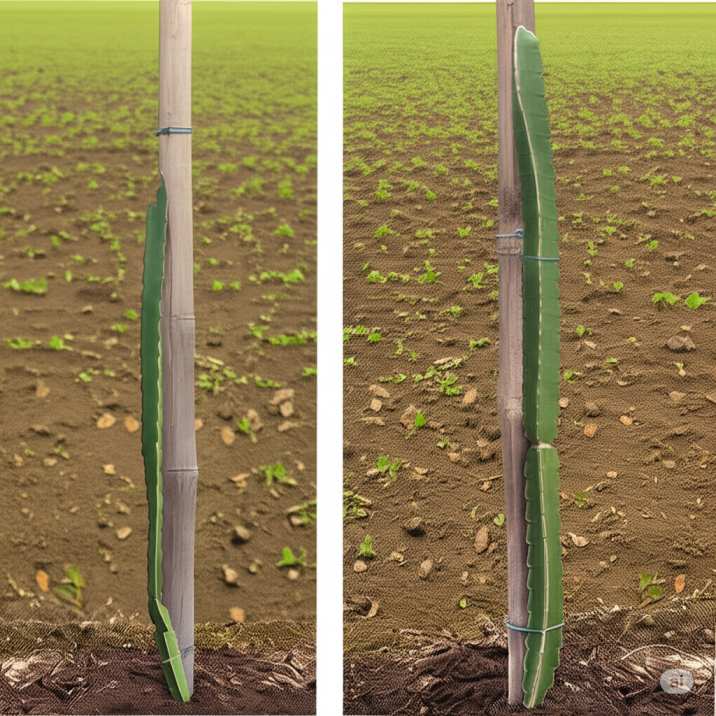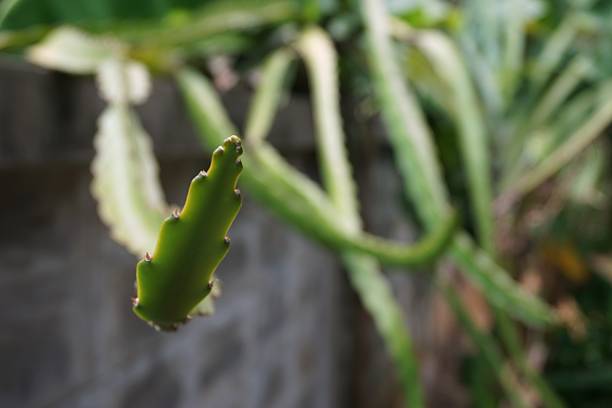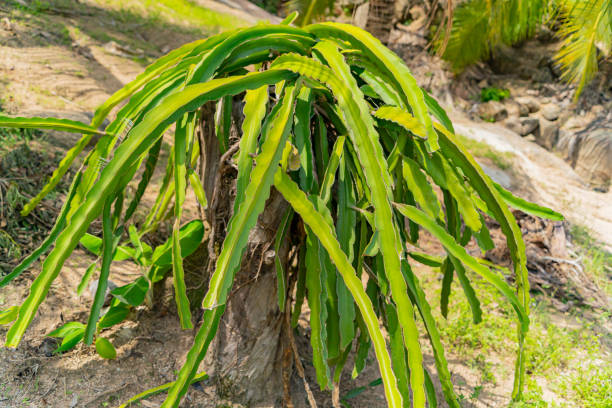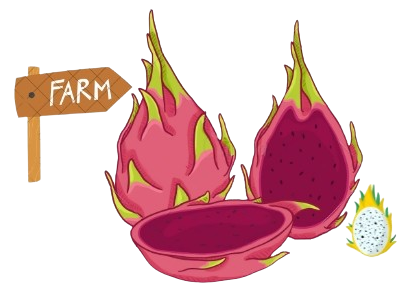Dragon fruit, also known as pitaya, is increasingly gaining popularity among farmers in India due to its unique taste and the potential for high returns. However, new growers often encounter Dragon Plants Grow Slowly, leading to frustration. If your dragon fruit plants aren’t growing as expected, there are several important factors to consider. Let’s break down the reasons why your plants may not be growing and how to boost dragon fruit growth and what you can do to fix it.
Common Causes of Slow Growth:

Reasons for slow dragon fruit plant growth checkout
1. Poor Soil Quality
One of the primary reasons for Dragon Plants Grow Slowly is poor soil quality. For optimal growth, dragon fruit plants need fertile soil that provides essential nutrients. If the soil is too acidic or alkaline, it can hinder the plant’s ability to absorb nutrients properly, leading to poor growth. In acidic soil, the plant struggles to absorb vital nutrients, while in alkaline soil, the plant faces similar issues.
Tip: How to boost dragon fruit growth – Ensure your soil’s pH level is between 6 and 7 for ideal growth. If the soil is too acidic, you can add lime to raise the ph. For alkaline soil, sulfur can help lower the pH and restore balance.
2. Improper Water Management
Water is essential for the growth of small dragon fruit plant, but it’s important to manage it carefully. Too little water can cause the plant’s internal fluids to dry out, affecting its growth. On the other hand, excessive watering can lead to root rot and stunt growth. Since dragon fruit plants have shallow roots, they need well-drained soil that does not become too wet or too dry.
Tip: Water your plants when the topsoil feels dry to the touch. During the rainy season, adjust your watering schedule to prevent overwatering. A good practice is to water every 5-7 days during the dry season, but this may vary depending on your local climate.
3. Poor Fertilizer Management
Dragon fruit plants require balanced nutrition for healthy growth. If your plants are not getting enough nutrients, Dragon Plants Grow Slowly. Key nutrients include nitrogen (N), phosphorus (P), and potassium (K), along with micronutrients like calcium, iron, and zinc. A deficiency in any of these nutrients can cause your plants to grow slowly or even turn yellow.
Tip: How to boost dragon fruit growth: Regularly apply balanced fertilizers with a ratio of NPK 19-19-19 to provide the necessary nutrients. Additionally, organic compost and manure can significantly improve soil fertility and overall plant health.
4. Pest and Fungal Issues
Pests and fungi can severely affect the growth of dragon fruit plants. Pests such as mealybugs and aphids damage the branches, causing stress to the plant. Similarly, fungal diseases like root rot damage the plant’s roots, preventing it from absorbing nutrients properly. These issues can drastically slow down the plant’s growth.
Tip: Regularly inspect your plants for pests and fungal growth. Use organic treatments like neem oil or chemical fungicides to keep your plants healthy. It’s also important to use proper spacing and pruning techniques to reduce the risk of disease.
How to boost dragon fruit growth

Follow and read this – Dragon fruit cultivation tips
1. Maintain pH Balance
How to boost dragon fruit growth – As mentioned earlier, maintaining the correct pH balance in the soil is crucial for dragon fruit growth. Use organic or chemical products to adjust the soil’s pH as needed. A pH level between 6 and 7 is ideal for optimal nutrient absorption.
2. Use Organic Fertilizers and Compost
Organic fertilizers and compost improve the soil’s fertility, which in turn supports the plant’s growth. These provide natural nutrients and help maintain a healthy root system. Composting also helps retain moisture in the soil, making it easier to manage water levels.
3. Implement Effective Irrigation Systems
Watering your dragon fruit plants properly is critical. A drip irrigation system is an excellent choice because it ensures that the plants receive the right amount of water without wastage. You can also use mulch around the base of the plants to retain moisture and keep the soil cool during hot weather.
4. Regularly Supplement with Micronutrients
Micronutrients like iron, zinc, and boron are essential for the overall growth and health of dragon fruit plants. Applying micronutrient-rich fertilizers 3-4 times a year can help boost plant growth and improve fruit production and you won’t face issue of Dragon Plants Grow Slowly
5. Pest and Disease Management
Preventing and managing pests and diseases is essential for healthy dragon fruit growth. Regularly spray your plants with fungicides or natural treatments like Trichoderma or Pseudomonas. Also, consider using shading nets and mulching to protect your plants from environmental stress.
Tip of the Day: Dragon fruit cultivation tips

As a dragon fruit grower, Dragon fruit cultivation tips are important taking care of your small dragon fruit plant requires regular attention and patience. While the soil, water, and fertilizer management are all important factors in ensuring healthy growth, the “Tip of the Day” is about How to boost dragon fruit growth and monitoring and adapting to the climate conditions.
Different seasons require different care for your dragon fruit plants. In summer, the plants need more water, but in the winter months, you may need to reduce watering frequency Dragon Fruit Growth Problems Also, temperature plays a significant role in the plant’s development. While dragon fruit plants thrive in warm climates, they can suffer if exposed to extreme cold as a result Dragon Plants Grow Slowly.
Here’s How to boost dragon fruit growth – you can optimize your care during different seasons:
- Summer: During the hot months, dragon fruit plants require more frequent watering. Their roots will be actively growing, so it’s essential to provide ample water to help them maintain hydration and thrive. A drip irrigation system with proper moisture levels will ensure the plants get consistent hydration. Additionally, ensure the plants are shaded from direct sunlight during peak hours to avoid excessive heat stress.
- Winter: The winter months usually require less water, but don’t leave your plants completely dry. Watering once every 7-10 days, depending on the temperature, will help maintain moisture levels without over-watering. Dragon fruit plants can handle cooler temperatures, but they should be protected from frost, which can stunt growth and damage the plant. You can use row covers or shade nets to protect your plants from extreme cold.
In addition to managing the seasonal needs of the small dragon fruit plant and how to boost dragon fruit growth – regular monitoring is key. Keep track of the soil’s moisture level, look out for pests, and adjust the watering schedule based on weather conditions. By staying on top of these elements, you can ensure your dragon fruit plants grow healthy and strong throughout the year.
Frequently Asked Questions (FAQs)
Q1: How do I know if my dragon fruit plant is not getting enough water?
A: Dragon fruit stores water in its branches, so if the plant has not been watered enough, the branches will become shriveled or yellowish. This indicates that the plant is stressed and needs water. It is recommended to water the plant every 6-7 days during dry spells.
Q2: How can I tell if my dragon fruit plant is lacking nutrients?
A: If your plant’s growth slows down, or the leaves turn yellow, this may indicate a nutrient deficiency. You may also notice the roots appearing above the soil surface, signaling that the plant is struggling for nutrients. Dragon Plants Grow Slowly – It’s time to apply a balanced fertilizer or compost.
Q3: What can I give my dragon fruit plants besides regular fertilizer for better growth?
A: Besides fertilizers, you can provide your plants with organic solutions like Jeev-Amrit, seaweed liquid fertilizer, and bone meal for calcium. These will promote healthy root growth and improve overall plant health.
Q4: How often should I water my dragon fruit plants in winter?
A: During winter, water your plants less frequently—around once every week to 10 days. However, monitor the soil moisture and adjust based on temperature conditions.
Q5: What pests should I be concerned about for dragon fruit plants?
A: Common pests include mealybugs, aphids, and scale insects, all of which can damage your plant. Fungal issues like root rot can also be problematic. Regularly inspect your plants and treat them with neem oil or other natural pest control methods.
Q6: Can dragon fruit grow in all types of soil?
A: No, dragon fruit requires well-drained, slightly acidic to neutral soil (pH 6-7). Avoid very sandy, highly acidic, or overly alkaline soils, as they can impede nutrient absorption.
Q7: How can I protect my dragon fruit plants from fungal diseases?
A: Use fungicides like Trichoderma or Pseudomonas, and apply them during seasonal changes or after rainfall. Proper drainage and soil aeration can also help prevent root rot.
Q8: What is the best time to plant dragon fruit?
A: The best time to plant dragon fruit is in the warmer months, typically after the last frost in early spring. This allows the plant to establish itself before the colder months.
Q9: Can dragon fruit plants tolerate frost?
A: Dragon fruit plants are sensitive to frost. While they can tolerate light frost, prolonged exposure to cold can damage the plant. Protect your plants during frost-prone periods with row covers or shade nets.
Q10: How do I encourage my dragon fruit plants to flower?
A: To encourage flowering, ensure your plants receive adequate sunlight and proper nutrition. Dragon Plants Grow Slowly – Pruning the plants to remove excess growth can also help redirect energy to flowering. Providing a support structure like a trellis will help the plants grow vertically and encourage more blooms.
By following these guidelines, you can ensure that your plants grows and Reasons for slow dragon fruit plant reduces. Dragon fruit plants grow optimally and produce healthy fruits.
IF you have any question regarding this do let me know in the comment section below.


Needed information